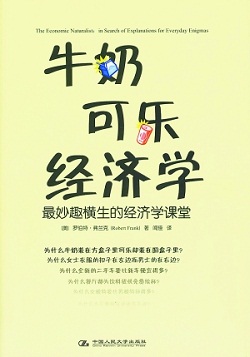Chapter 1 economics explains life
economics explains life
When I was studying at Cornell University in the 1990s, my friend told me that Robert.Professor Frank's economics lectures were lively and lively, and they were very popular with the students, so I also went to listen to them.Sure enough, there were often bursts of laughter in the classroom. There should be some humorous witticisms. Unfortunately, my English listening is too poor. I can even guess the principles. half a step.
Robert.In class, Professor Frank often asks students to write down the economic phenomena they think of and analyze them with economic methods.Good writing is often praised.Some of the content of this book comes from these short essays written by the students (of course, Professor Frank made revisions), and the other part is written by himself.The content of this book is to use the principles and methods of economics to explain various phenomena in life, and to deepen the understanding of economics through these examples and explanations.This is also the way Professor Frank teaches economics.Students love to listen to this kind of teaching, and when they write books, readers also love to read them.
This book focuses on phenomena that we are all too familiar with in reality but don't notice.For example, why the milk box is square and the Coke bottle is round; why the worthless water in the bar is charged but the peanuts are free; why female models earn more than male models; why drinks after many years can be free Drink refills; why many supermarkets are open 24 hours; why whales are endangered but chickens aren't; why nearly new used cars are much cheaper than new; why DVD formats vary from place to place, but CDs are the same; why humility on one-way streets reduces efficiency ; why physically attractive people are also smarter, etc.
Of course, the author pointed out that there are many more phenomena than this in reality, not to discuss the facts, but to tell you the economic principles behind them.Theory is gray, but the tree of life is evergreen.If you talk about the principles of economics at the beginning, you will definitely feel boring, but starting with these phenomena that you see every day but never ask why, you must be very interested and have to read on.
And after reading it, you will feel enlightened, understand the principles of economics, and know how to use these principles to explain more phenomena.This is when you become a fan of economics.In this pleasant and relaxed reading, you have mastered the seemingly profound principles of economics, improved your understanding of the world, and made more rational decisions.
Of course, starting from the phenomenon is not to discuss the facts and explain these phenomena, but to give you a systematic introductory knowledge of economics.The phenomena involved in the book are all trivial matters of everyday life.The theoretical tool used to explain these phenomena is microeconomics, which is the basic content of this book.Since the writing method of this book is different from that of ordinary textbooks, the structure of the book is not in the textbook style, but each chapter is developed around a center.
The introduction can be regarded as an introduction, introducing the two core concepts in microeconomics, opportunity cost and cost-benefit principle.After Chapter 1, some important principles of microeconomics are developed.
Chapter 1 influences cost-benefit principles and their application in product design.
Chapter 2 talks about the core supply and demand theorem of microeconomics.
Chapter 3 deals with the relationship between income and contribution.
Chapter 4 deals with product production, pricing, and competition.
Chapter 5 discusses public resources.
Chapter 6 talks about the importance of clear property rights.
Chapter 7 is information economics, centered on the theory of information asymmetry.
Chapter 8 deals with the impact of cultural and other differences across countries on economic behavior.
Chapter 9 is about behavioral economics, which introduces psychology into economics to analyze problems.
Chapter 10 deals with the impact of economics on informal social relationship markets.It is to use economics to explain other social behaviors, including love, marriage and so on.
The final chapter 11 has little to do with the basics and is a tribute to the students.After reading this book, you will know that it includes almost all the content of microeconomics, especially some cutting-edge content.For example, behavioral economics, information economics, etc.But the focus of the author's exposition is not to introduce the content itself, but to let you understand the seemingly simple principles through the explanation of various phenomena.
Many of the examples used in the book come from the United States, but these phenomena are also familiar to you when you read them in China.Of course, China has some phenomena with its own characteristics, but you will understand all this after reading Chapter 8 of the impact of cultural and other differences on economic behavior in various countries, and you will also apply the principles of economics to you.
Starting to learn economics from a book like this may not be very deep.If you aspire to be a professional economist, you need to learn more advanced content.But this book serves two important purposes.For professional economists, it provides you with rich cases and deepens your understanding of those esoteric principles.For general readers, entering the palace of economics from this book and learning to use economics to think about things around you will make you live more rationally.Anyone can benefit from this book.Believe it or not, you will know after reading it.

